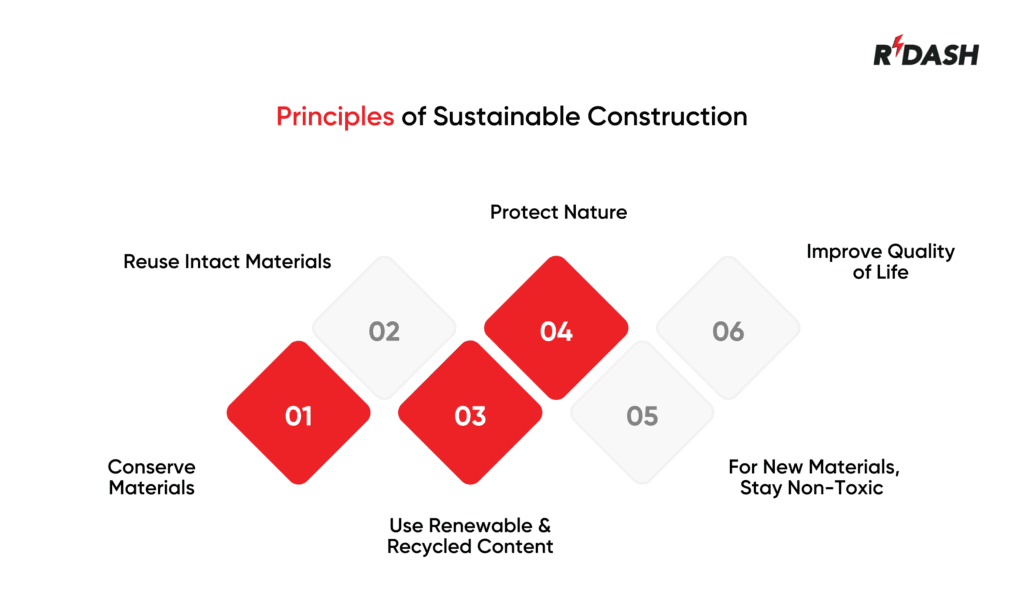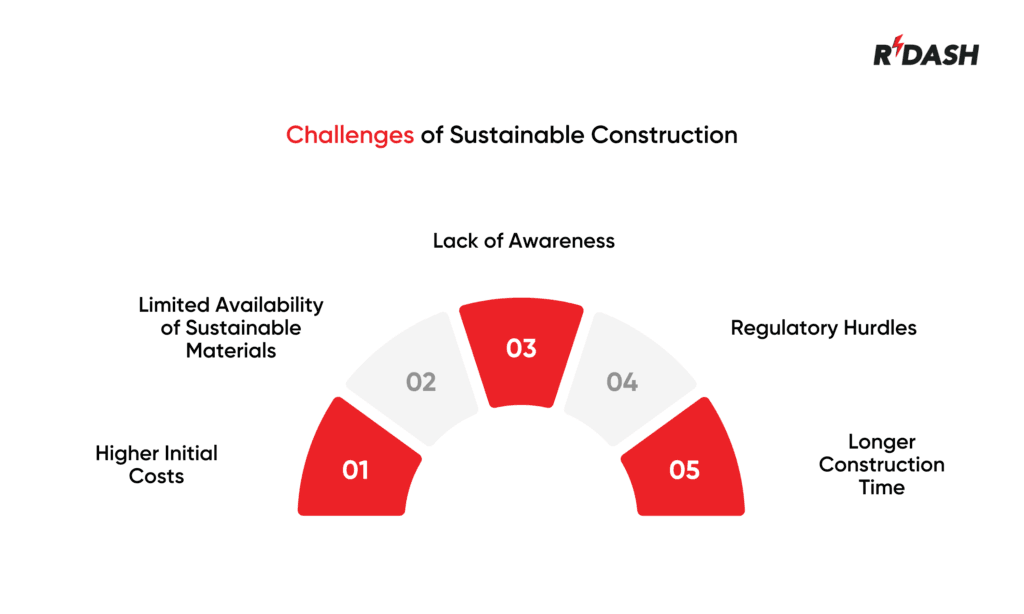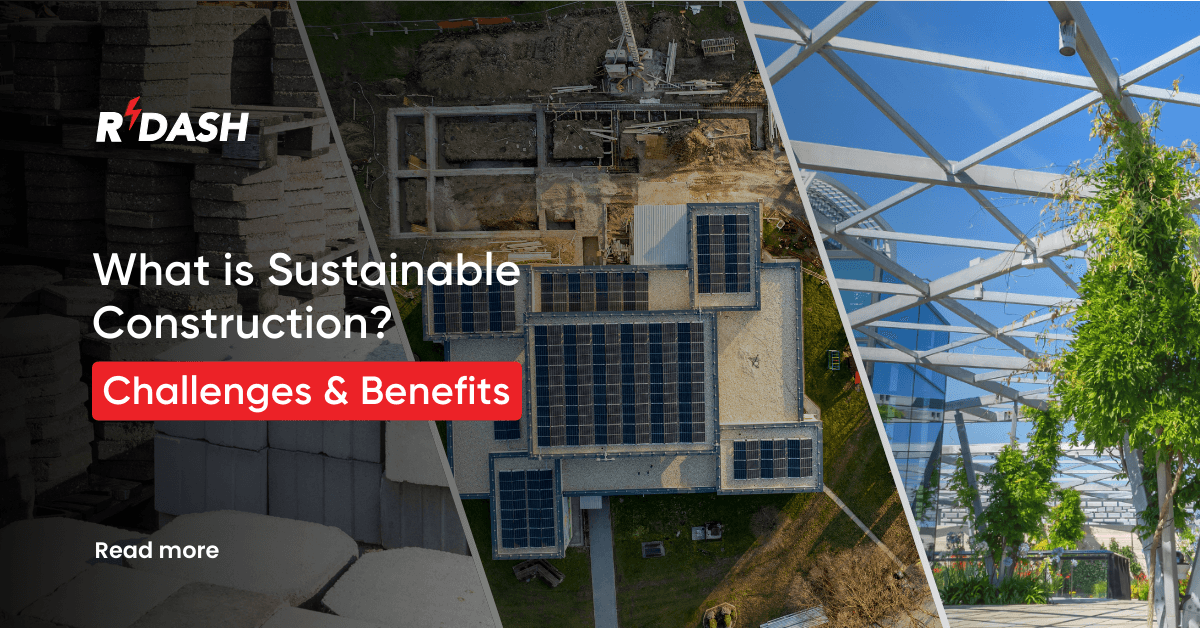What is Sustainable Construction?
Sustainable construction is a way of building that aims to reduce the negative impact on the environment while ensuring that the structure is durable, efficient, and safe. The goal is to minimize waste, reduce energy consumption, and make use of eco-friendly materials. In sustainable construction, every stage of the project, from planning to completion, is considered with environmental responsibility in mind.
This approach has become increasingly important due to the growing concerns about climate change, resource depletion, and environmental pollution. Sustainable construction focuses on balancing the needs of present and future generations while making buildings safer, more energy-efficient, and environmentally friendly.
6 Principles of Sustainable Construction
Sustainable construction isn’t just about using eco-friendly materials. It involves a set of principles that guide the entire building process. Here are six key principles of sustainable construction:

1. Conserve Materials
One of the main goals of sustainable construction is to conserve materials. This means using fewer resources during the building process and ensuring that those materials are used efficiently. Builders and architects often aim to reduce waste by carefully planning the amount of materials needed, as well as by opting for materials that are locally sourced to reduce transportation costs and carbon footprints. Conserving materials also involves selecting materials that last longer, reducing the need for frequent repairs or replacements.
2. Reuse Intact Materials
Another important principle of sustainable construction is to reuse materials that are still in good condition. Instead of discarding old materials from a previous building or demolition, many sustainable construction projects aim to give these materials a second life. Reusing intact materials can include things like reclaiming bricks, wood, steel, or glass to be used again in new projects. This reduces the demand for new resources, lowers waste, and keeps usable materials out of landfills.
3. Use Renewable and Recycled Content
Using renewable and recycled content in construction materials is another core principle of sustainable building. Renewable materials are sourced from nature and can naturally regenerate, such as wood and bamboo. Recycled materials, like recycled metal or glass, are another way to reduce waste. These materials often require less energy to produce and have a much lower environmental impact than virgin materials. For example, recycled steel can be used in place of new steel, saving on energy costs and reducing the carbon footprint of the project.
4. Protect Nature
Sustainable construction is not just about the materials used but also about how the building interacts with its environment. Protecting nature means designing buildings in a way that minimizes the impact on the surrounding ecosystem. This could include measures like planting trees around the site, reducing water usage, protecting wildlife habitats, and avoiding the destruction of natural landscapes. Builders also pay close attention to water runoff and energy efficiency, using techniques to reduce environmental damage during the construction process.
5. For New Materials, Stay Non-Toxic
When using new materials, it’s essential to choose those that are non-toxic and free from harmful chemicals. Many conventional construction materials, like certain paints, glues, and finishes, contain substances that can be harmful to the environment and human health. Sustainable construction focuses on materials that are safe, non-toxic, and have minimal environmental impact. For example, low-VOC paints and natural insulation materials are healthier alternatives to the toxic chemicals found in traditional construction products.
6. Improve Quality of Life
The ultimate goal of sustainable construction is not just to protect the environment, but also to improve the quality of life for the people who use the buildings. Sustainable construction focuses on creating buildings that are healthier, more comfortable, and more efficient. This can mean good indoor air quality, natural light, better ventilation, and comfortable temperatures. Sustainable buildings are designed to be energy-efficient, leading to lower utility costs for those living or working inside them. A well-designed, sustainable building not only benefits the environment but also enhances the well-being of the people living or working inside it.
Importance of Sustainable Construction
Sustainable construction is becoming more important than ever. As the world faces growing environmental challenges, such as climate change and resource depletion, the need for building practices that minimize environmental impact has never been greater. Sustainable construction focuses on creating buildings that are energy-efficient, use eco-friendly materials, and are built to last, all while reducing waste and pollution.
The importance of sustainable construction lies in its ability to reduce the carbon footprint of the built environment. A large share of energy consumption and greenhouse gas emissions comes from buildings. By adopting sustainable practices, we can reduce the impact that construction has on the planet, ensuring a better future for generations to come. In addition, sustainable construction helps preserve resources, reduces costs, and improves the health and comfort of the people who live or work in these buildings.
Benefits of Sustainable Construction
Sustainable construction offers several key benefits, both for the environment and for the people involved in the construction process. These benefits make it an attractive option for builders, developers, and property owners alike:
1. Energy Efficiency
A key advantage of sustainable construction is enhanced energy efficiency. These buildings are planned to consume less energy for heating, cooling, and lighting, which reduces overall energy use and helps lower utility expenses for the occupants. Incorporating renewable energy sources like solar panels can further reduce energy costs and carbon emissions.
2. Cost Savings
Although sustainable construction may involve higher initial expenses, it can result in substantial savings over time. Energy-efficient buildings have lower operational costs, as they require less energy to maintain a comfortable environment. Additionally, sustainable construction often involves using durable, low-maintenance materials that reduce repair and replacement costs over time.
3. Health and Well-being
Sustainable buildings promote better indoor air quality, natural light, and proper ventilation, all of which contribute to the health and well-being of the occupants. By reducing exposure to harmful chemicals, pollutants, and allergens, sustainable construction can create healthier living and working environments. This focus on health also extends to the workers involved in the construction process, ensuring safer and more comfortable working conditions.
4. Environmental Protection
Sustainable construction practices help protect the environment by minimizing waste, reducing energy consumption, and using environmentally friendly materials. By adopting green building practices, such as using recycled or renewable materials, reducing water consumption, and protecting local ecosystems, the construction industry can help conserve natural resources and reduce pollution.
5. Increased Property Value
Buildings that are sustainably designed and constructed tend to have higher market value. Sustainable properties are increasingly in demand as more people recognize the long-term benefits of energy-efficient and eco-friendly buildings. These buildings often attract higher-quality tenants, who are looking for lower operating costs and healthier living environments.
Challenges of Sustainable Construction
While sustainable construction brings many advantages, it also presents its own set of challenges.
These challenges can make it more difficult to adopt sustainable practices in some cases, but they can be overcome with careful planning and commitment to the long-term goal of sustainability.

1. Higher Initial Costs
One of the biggest obstacles in sustainable construction is the higher initial investment. Sustainable materials, energy-efficient systems, and eco-friendly technologies tend to be more expensive, which can make it challenging for builders and property owners to justify the upfront costs, particularly when working with limited budgets. However, the long-term savings from reduced energy consumption and lower maintenance costs often balance out these higher initial expenditures.
2. Limited Availability of Sustainable Materials
Although the demand for sustainable construction materials is growing, they are still not as widely available as traditional building materials. In some regions, eco-friendly materials may be difficult to find or come at a higher cost. Additionally, some sustainable materials may not yet be as proven or reliable as more commonly used options, which can make it harder for builders to adopt them in their projects.
3. Lack of Awareness and Knowledge
Many people in the construction industry still lack a full understanding of sustainable building practices. This knowledge gap can make it challenging to implement green construction methods and technologies. Builders, contractors, and architects may not have the necessary training or expertise to design and construct sustainable buildings. To overcome this, education and training programs are crucial to help professionals gain the skills they need to implement sustainable practices effectively.
4. Regulatory Hurdles
In some regions, regulations and building codes may not fully support sustainable construction. Outdated codes can make it difficult for builders to incorporate green technologies and sustainable materials into their projects. Furthermore, local governments might not offer incentives for sustainable building practices, which can discourage developers from investing in eco-friendly projects. It’s important for governments and regulatory bodies to update building regulations and provide financial incentives to support sustainable construction.
5. Longer Construction Time
Sustainable construction projects might require more time to finish compared to conventional projects. The need for careful planning, sourcing of eco-friendly materials, and the installation of energy-efficient systems can all add time to the construction process. However, the long-term benefits, such as lower operating costs and a healthier environment, make the extra time investment worthwhile.
Conclusion
Sustainable construction is essential for reducing the environmental impact of the building industry while creating safer, healthier, and more cost-effective spaces for people to live and work in. While the initial costs and challenges can be daunting, the benefits far outweigh the drawbacks in the long run. By implementing sustainable building practices, we can help ensure that future generations inherit a world that is not only practical and visually appealing but also environmentally sustainable.






